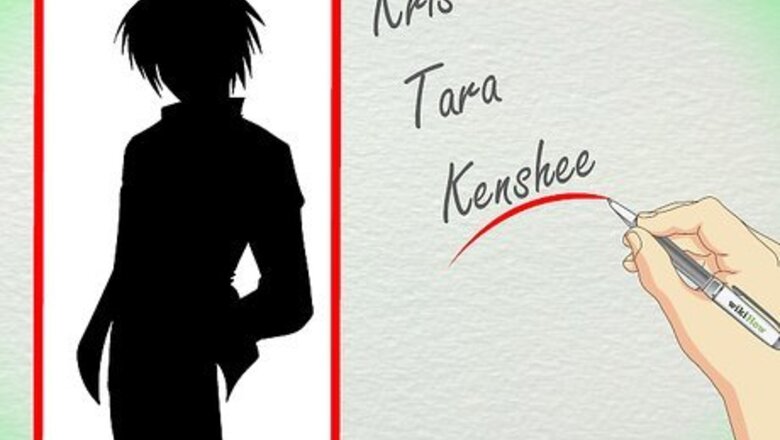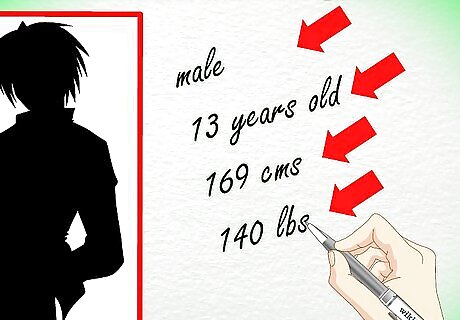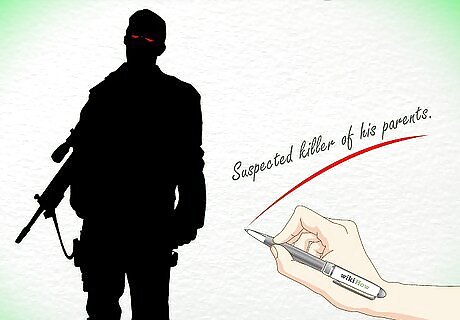
views
Using Basic Details and Physical Description

Name your character. A big identifier of your character will be their name. Think about people you know in real life who remind you of the character or who inspired the character. You can also play on an existing name you feel fits with the character; try using a variation of the name or changing the spelling. For example, Kris or Chrissie instead of Chris, or Tara instead of Tanya. Be careful with making up names. Made up names may make your character less believable. Additionally, avoid making up names for character's from another (nonfictional) culture. It will likely be unrealistic and may offend. Look for names that fit with your character's background and don't seem odd in terms of your character's role or position. Try looking up historical name trends to find a name that fits your character's time period. There are several character name generators online that you can also use, filtering by background and gender.

Note your character's gender, age, height, and weight. If your character was to fill out a census or a form at a doctor's office, what would they specify? Though you may not use this character information in your story or novel, your character's gender, and age will affect their character voice and their point of view. For example, the young child character, Scout, in Harper Lee's To Kill a Mockingbird will view the world of the novel differently than her father, Atticus Finch, an older man. These don't have to be exact in most cases; "young teen" or "mid-thirties" will usually suffice.

Describe your character's appearance. It's important to specify your character's physical characteristics. Often, description of characters focuses on hair color or eye color, and these details can help signal to your reader that your character has a certain ethnic background or appearance. These descriptions can also indicate a certain type of character. For example, describing your character's physical appearance as: “She had dishwater blonde hair and gray eyes that glazed over when she was bored” not only gives your reader a clear physical description, it also shows the character's personality.

Create distinguishing markers or scars on your character. Harry Potter's lightning bolt scar is a good example of a distinguishing marker that identifies his character and makes him unique. You can also use birthmarks, like a mole on your character's face, or a marker due to an accident, like a burn mark or a scar due to stitches. These scars or markers can make your character feel distinct to your reader. They can also tell the reader more about your character. In To Kill a Mockingbird, Scout's brother Jem is characterized on the first page of the novel through a description of his broken arm: “When he was nearly thirteen, my brother Jem got his arm badly broken at the elbow. When it healed, and Jem's fears of never being able to play football were assuaged, he was seldom self-conscious about his injury. His left arm was somewhat shorter than his right; when he stood or walked, the back of his hand was at right angles to his body, his thumb parallel to his thigh. He couldn't have cared less, so long as he could pass and punt.” Harper Lee uses the injury, or physical marker, to introduce Jem's character and tell the reader that he has a shorter left arm, a distinguishing characteristic that makes him a more nuanced and believable character.

Note your character's fashion sense. Clothing can be a great way to show the reader more of your character's personality and preferences. A character who wears punk t-shirts, black jeans, and Doc Martens will come across as a rebellious character, while a character who wears a sweater set and loafers may come across as a more conservative character. Be specific when you are describing a character's clothing, but don't repeat descriptions too much in the narrative. Establishing your character's style of dress once will create a clear picture in the reader's mind that they can refer back to. In Raymond Chandler's The Big Sleep, the main character Philip Marlowe describes his clothing in two concise sentences: “I was wearing my powder-blue suit, with dark blue shirt, tie and display handkerchief, black brogues, black wool socks with dark blue clocks on them. I was neat, clean, shaved and sober, and I didn't care who knew it.” Chandler uses very specific detail to paint a clear image of Marlowe and he injects the description with Marlowe's voice, “I didn't care who knew it,” adding more depth to the description.

Determine your character's background and class. Your character's station in life will affect how she navigates certain situations and how she will react to everyday occurrences. A young African American man living in Washington, D.C. will have a different experience or perspective than a young Southern man living in Little Rock, Arkansas. A middle class woman living in New York will have different daily experience than a woman living on food stamps in New York. Your character's background and class experience will be an integral part of their perspective as a character. Though it is not essential that you announce your character's background and class to the reader, your character will feel more realistic and true if their station in life factors into their point of view. The characters in the fiction of Junot Diaz, for example, use colloquial terms that indicate class and background to the reader. In Diaz's short story “The Cheater's Guide to Love” he notes: “Maybe if you'd been engaged to a super-open-minded blanquita you could have survived it—but you're not engaged to a super-open-minded blanquita. Your girl is a bad-ass salcedense who doesn't believe in open anything; in fact, the one thing she warned you about, that she swore she would never forgive, was cheating.” In this story, Diaz uses Spanish terms to indicate the character/narrator's background, without having to tell the reader directly that the narrator is Spanish.

Conduct research on your character's profession or career. Another way to make your character more believable on the page is to delve into the details of their profession or career. If you are writing a character who works as an architect, this character should know about how to design a building and may see a city skyline in a unique way. Or if you are writing a character who works as a private detective, this character should know basic P.I. protocol and how to solve a case. Use library books and online sources to make your character's career convincing in your story. If possible, try to speak to someone who is in the profession of your character. Interview them about their daily habits at work to make sure you are getting the details of their profession right. They may even be willing to give feedback on your writing.
Using Character Motivation

Give your character a purpose or desire. One of the most distinguishing aspects of your character should be their purpose or want in the story. Your character's goals should drive the story and their goal should be unique to their character. For example, your character might be a young African American man who is trying to get into the NBA. Or your character might be an old woman who is trying to reconnect with her long lost son. Making your character's purpose or goal specific will help them seem more realistic and believable. Another key aspect of your character's goal is that your character should have a small goal, such as trying to get a girl, and a large goal, such as confirming love is real. Try to give your character small and a large goals so their story feels specific and also general, or universal, to your reader.

Consider your character's strengths and weaknesses. A hero with no flaws or a villain with no heart will be flat characters on the page. Give your character strengths and weaknesses to create a well rounded character who is also relatable to your reader. The protagonist's weaknesses should be out weighed just slightly by your character's strengths, especially if they are going to be the underdog or underachiever in your story. For example, your character may be shy, but has a good mind for solving riddles and puzzles. Or your character may struggle with anger or rage, but tries to maintain control over their emotions. Balancing your character's strengths with weaknesses (and vice versa) will make your character more endearing and relatable to your reader, which will then make the character feel more realistic. Overly perfect characters who unrealistically lack flaws are called "Mary Sues".

Give your character a backstory. Not all characters have to be motivated by a past trauma or fear, but creating a backstory for your character with events which may have harmed or damaged them can create tension in the character's present life. A backstory is events or moments in the character's life that happens before the story begins. A backstory can also allow you to make the character more believable on the page. A character who refers to previous events will widen the scope of the story and give the character a more well developed presence in the story. For example, in Diaz's short story “The Cheater's Guide to Love”, the reader is told of backstory, the narrator's past transgressions while he was with his girlfriend. This backstory becomes the reason why the narrator's girlfriend leaves him. So the backstory is doing two things in the story: it is showing the reader more about the narrator and it is a major plot point in the story. It also widens the scope of the story, as the reader is dropped into the narrator's immediate drama (the girlfriend leaving him) but this drama stems from past events that the narrator must face in the present.

Create a nemesis for your character. Another way to create a more realistic character in your story is to create a person or force that is working against your character. A nemesis will add an element of reality to the story, as in real life, we are often faced with opposing forces or challenging individuals. The nemesis could be in the form of a nosy neighbor, an annoying family member, or a troublesome partner. Your character's nemesis should correspond with the character's purpose or desire. For example, a character who is trying to land a basketball scholarship may have a nemesis in the form of a rival teammate, or an overbearing coach. A character who is trying to win back a girl he cheated on may have a nemesis in the form of his inability to control his own desires or be monogamous.
Using Dialogue

Don't be afraid to use colloquial terms in dialogue. Colloquialisms are informal words, phrases or slang. Your characters should sound as unique as the individuals you encounter every day, and that includes any slang or informal terms they might use. For example, two teenage boys likely will not greet each other with: “Good day, sir.” Instead, they may say “What's up?” or “What's goin' on?” Be careful about using too many colloquial terms in your dialogue. It can begin to feel distracting or gimmicky if it is overused. Strive for a balance between proper English terms and slang or colloquialisms.

Think about code switching. Code switching is a language shift made by a character in response to who they are speaking to. It occurs often in everyday life, especially for individuals from different backgrounds or classes who are trying to assimilate or blend in. If you are writing a character from a certain background, setting, or class, you should consider how they will might use local slang in their dialogue and description depending on who they are speaking to in a scene. A Jamaican man speaking to another Jamaican man, for example, will likely use patois and slang like “Yah, mon” or “Stay ire”. But the same Jamaican man speaking to a white police officer may use more formal speech like “Yes, sir” or “Stay cool”.

Use dialogue tags. Dialogue tags, or speech tags, are like signposts. They attribute written dialogue to characters. Some of the more commonly used dialogue tags are “said” , "asked" and “told”. Dialogue tags don't need to be fancy or overly descriptive. Their primary purpose are to show which characters speak and when. But you can also build believable characters through dialogue tags. Each tag should contain at least one noun or pronoun (Scout, she, Jem, he, you, they, we, the man, etc.) and a verb indicating how the dialogue is being spoken (said, asked, whispered, remarked). For example, “Scout said to Jem…” or “Jem whispered to Scout…” You can add adjectives and adverbs to tags to provide more information about the speaker. For example, “Scout said quietly to Jem” or “Jem whispered harshly to Scout”. Adding an adverb can be a quick and useful way to indicate a certain mannerism or emotion in a character. But be wary of overusing adjectives and adverbs in your dialogue tags. Try to only use one adjective or adverb per scene for one character's dialogue tag.

Read the dialogue out loud. Your character's dialogue should feel unique to their character and representative of how they interact with others. Good dialogue in fiction should be doing more than simply telling the reader how a character gets from A to B, or how the character knows another character. Read the character's dialogue out loud to ensure it sounds like speech a person might say to another person in the scene. The dialogue should also sounds true to the character. For example, in To Kill a Mockingbird, Lee uses dialogue to distinguish the characters in a scene. She also uses colloquial terms that represent children living in a small Southern town in the 1950s.“Hey.” “Hey yourself,” said Jem pleasantly. “I'm Charles Baker Harris,” he said. “I can read.” “So what?” I said.“I just thought you'd like to know I can read. You got anything needs readin' I can do it…”“How old are you,” asked Jem, “four-and-a-half?” “Goin' on seven.” “Shoot no wonder, then,” said Jem, jerking his thumb at me. “Scout yonder's been readin' ever since she was born, and she ain't even started to school yet. You look right puny for goin' on seven.” Lee makes Jem's dialogue distinct from Charles Baker Harris' dialogue and Scout's dialogue by using slang terms and colloquialisms. This establishes Jem as a character and creates a dynamic between all three speakers in the scene.


















Comments
0 comment